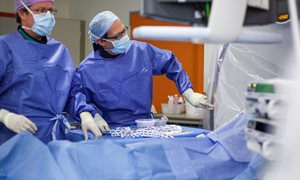
A new molecule that specifically binds to tumor cells can provide better treatment of prostate cancer. That is one of the conclusions from the thesis of Yvonne Derks of Radboud university medical center. With this new molecule, surgeons might be able to recognize and kill tumor cells during surgery.
The prostate is an organ located under the bladder in men and has an important role in reproduction. Prostate cancer is the second leading cause of cancer-related death in the Western world among men. In the Netherlands, 2,800 men die annually from the effects of this disease. Treatment of primary prostate cancer is largely based on surgical removal of the prostate. But because some patients already have metastases in the lymph nodes at the time of surgery, or have a tumor lying on the edge of the prostate, it is often difficult to remove all tumor cells.
During her PhD, Yvonne Derks, postdoc at the Imaging Department of Radboud university medical center, investigated improvements in surgical removal of the tumor in the prostate. For this, she used a new targeting agent in prostate cancer: PSMA, a protein on the cell surface of prostate cancer cells. By using molecules that bind to PSMA, the so-called PSMA ligands, these cells can be recognized, allowing surgeons to operate patients in a highly targeted way.
Imaging and therapy
Derks developed and researched a PSMA ligand able to detect prostate cancer cells. Thanks to a fluorescent part, surgeons can see these cells during surgery, and know which parts of the prostate to remove, Derks explains. 'This allows surgeons to better differentiate tumor tissue from healthy tissue.' Additionally, the PSMA ligand has a radioactive part. 'Radioactivity moves through tissue and is easy to detect,' says Derks. 'This also allows us to detect and remove lymph nodes with tumor cells lying deeper in the body.'
An additional advantage of the PSMA ligand is that the fluorescent part can not only image tumor cells, but can also kill these cells. This is because the activation of this ligand causes damage. ‘With this ligand we can conduct tumor cell imaging, remove them in a targeted way, and kill the remaining cancer cells,’ says Derks. 'That makes this method imaging and therapy in one.'
Complete development
Derks was involved in the complete development of the ligand. 'We made about twenty molecules, which we tested in the laboratory. We screened the best molecules in an animal model of prostate cancer, and then on cancer tissue taken from patients during surgery, just after prostate removal.' For the latter part of the study, Derks used tumor tissue and healthy tissue from 15 patients with prostate cancer. ‘We saw that the ligand was well absorbed and cancer cells were easily distinguishable from surrounding tissue.'
Delayed imaging
In addition to improving imaging during surgery, Derks and her colleagues worked to improve prostate cancer imaging more broadly, targeting the radioactive part of the ligand. 'The radioactive part that is normally used with this PSMA ligand has a short half-life, meaning we can't track its uptake in the tumor very well,' says Derks. 'By using a radioactive label with a longer half-life, we can more accurately follow cancer cells over time.' This new approach was tested in one patient and proved safe and possible. 'We saw an additional tumor appear in this patient that we probably wouldn't have found otherwise. But to confirm these claims, we need to do more research.'
Meanwhile, Derks and her colleagues have patented the most promising PSMA ligand and are in conclave with companies that want to develop the molecule, opening the door to the first clinical trial in humans. 'We have followed the whole process from molecule to human,' says Derks. 'Eventually, hopefully, it will become clear how the ligand behaves in patients with prostate cancer during surgery. With that, our research can contribute to better treatment for prostate cancer patients.’
More information about this dissertation
Dissertation on 8 September at 10.30 am by Yvonne Derks. Title: PSMA ligands for imaging and therapy of prostate cancer. (Co-)promoters: Prof. Dr. S. Heskamp, Dr. M. Rijpkema, Dr. D. Löwik and Dr. S. Lütje. The defense can be followed via this livestream.
-
Want to know more about these subjects? Click on the buttons below for more news.
More information
Pauline Dekhuijzen

wetenschaps- en persvoorlichter
Related news items






